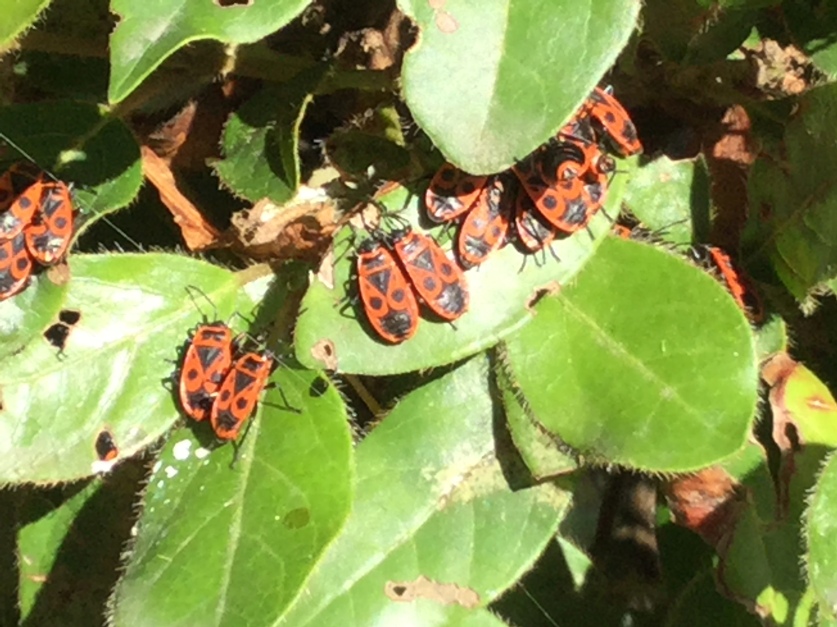(If you are a long-term reader you may have read the original post I wrote on this topic in 2016. This is an up dated version.)
Are you wondering ‘Why have the gendarmes returned?’ or ‘What has happened now? Has there been another break-in?’ Thankfully, none of these. These gendarmes are not local policemen but the small red creatures that can be found in our garden, in Castelnaudary S.W. France, at this time of year.

When I first saw them, from a distance, I thought that these little bugs were a type of ladybird, mainly because of the colours. After some research, I discovered that these striking looking insects are often called ‘les gendarmes’ in this part of the world.
Apparently, (more research!) this is because red and black were the colours of the original gendarme uniforms when they were still classified as soldiers and were part of the army.

However, for English speakers, these fascinating insects are known as ‘firebugs’. I think this name suits them perfectly! I must admit I had never seen nor heard of them before coming to Castelnaudary.
This is a close up of a firebug on the outside wall of our house. They move surprisingly quickly!

Some random but interesting facts about firebugs:
- Their scientific name is Pyrrhocoris apterus.
- Firebugs are gregarious and live in colonies which can consist of several hundred or even thousands of individuals.
- They love the sun. I frequently see hoards of them sunbathing on our terrace!
- You can spot them at the bottom of walls, hedges and the base of trees, especially Lime trees. This is because they like the taste of the lime seeds. We have a large lime tree in our back garden, quite close to the house, and this is where we see them the most.
- Firebugs also eat dead insects; very useful in my opinion!
- They have a rostrum which is a beak-like projection or proboscis. They ingest food through this by boring a hole in the shell of fallen seeds and sucking up the remaining juice.
- They have few natural enemies.
- Firebugs are not poisonous.
- Neither do they sting or bite.
- They are not a threat to plants.
- Almost everywhere in Europe and in large parts of Asia is where they can be found, although I have never seen any in the UK.
- Firebugs hibernate under stones, bark and leaves.
- They come out of hibernation in mid-March.
- Mating usually takes place in April and May and can last for several hours or even days.
- Female Firebugs lay between 60 to 80 eggs.
- Their average lifespan is 14 months.
I hope you have enjoyed reading about this rather interesting bug! Have you have come across firebugs? If you have I’d love to know where!
I am linking this post with the very entertaining #PoCoLo




Lots of “gendarmes” in our garden in Castel. Lovely little things and so busy, even in this stifling heat.
LikeLiked by 2 people
Yes, there’s something very endearing about them and they do always seem busy! As I’ve got older, I’ve found that I can’t just take the heat the way I could when I was younger and 40 degrees is definitely stifling. Thank goodness for shutters. Thanks for commenting.
LikeLiked by 1 person
It was interesting to learn about these ladybird like insects June.
LikeLiked by 2 people
Thank you, Marion and for taking the time to comment.
LikeLiked by 2 people
It’s always great to learn about a friendly and helpful creature!
LikeLiked by 2 people
Thank you, Michele. There is something rather appealing about these little bugs! #pocolo
LikeLiked by 2 people
I’ve never seen a firebug but they look beautiful. I’d be happy to welcome them to my garden.
LikeLiked by 2 people
There is something very appealing about them! Thanks for commenting #pocolo
LikeLiked by 1 person
I have some on my hibiscus. I live on the Isle of Wight, UK.
LikeLiked by 2 people
I imagine they might like the climate on the Isle of Wight! Thanks for taking the time to comment.
LikeLiked by 1 person